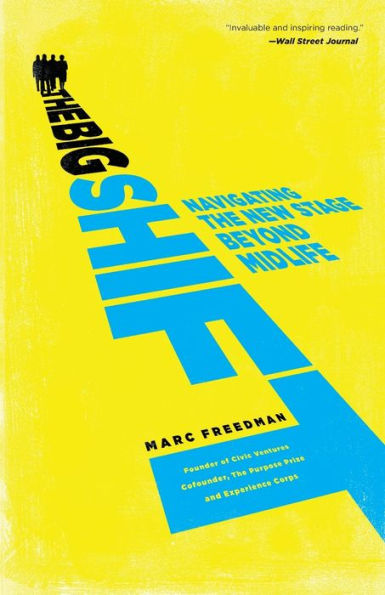The Big Shift: Navigating the New Stage Beyond Midlife
Marc Freedman, hailed by theNew York Timesas "the voice of aging baby boomers [seeking] meaningful and sustaining work later in life," makes an impassioned call to accept the decades opening up between midlife and anything approximating old age for what they really are — an entirely new stage of life, which he dubs the encore years.
In The Big Shift, Freedman bemoans the fact that the discussion about longer lives in America has been entirely about the staggering economic costs of a dramatically aging society when, in reality, most of the nation's 78 million boomers are not getting old — at least not yet. The whole 60- to 80-year-old period is simply new territory, he writes, and the people in this period constitute a whole new phenomenon in the 21st century.
The Big Shiftis animated by a simple premise: that the challenge of transitioning to and making the most of this new stage — while deeply personal — is much more than an individual problem; it's an urgent social imperative, one affecting all generations. By embracing this time as a unique period of life — and providing guidance, training, education and support to the millions who are in it — Freedman says that we can make a monument out of what so many think of as the leftover years. The result could be a windfall of talent that will carry us toward a new generation of solutions for growing problems in areas like education, the environment, and health care.
"1102152630"
In The Big Shift, Freedman bemoans the fact that the discussion about longer lives in America has been entirely about the staggering economic costs of a dramatically aging society when, in reality, most of the nation's 78 million boomers are not getting old — at least not yet. The whole 60- to 80-year-old period is simply new territory, he writes, and the people in this period constitute a whole new phenomenon in the 21st century.
The Big Shiftis animated by a simple premise: that the challenge of transitioning to and making the most of this new stage — while deeply personal — is much more than an individual problem; it's an urgent social imperative, one affecting all generations. By embracing this time as a unique period of life — and providing guidance, training, education and support to the millions who are in it — Freedman says that we can make a monument out of what so many think of as the leftover years. The result could be a windfall of talent that will carry us toward a new generation of solutions for growing problems in areas like education, the environment, and health care.
The Big Shift: Navigating the New Stage Beyond Midlife
Marc Freedman, hailed by theNew York Timesas "the voice of aging baby boomers [seeking] meaningful and sustaining work later in life," makes an impassioned call to accept the decades opening up between midlife and anything approximating old age for what they really are — an entirely new stage of life, which he dubs the encore years.
In The Big Shift, Freedman bemoans the fact that the discussion about longer lives in America has been entirely about the staggering economic costs of a dramatically aging society when, in reality, most of the nation's 78 million boomers are not getting old — at least not yet. The whole 60- to 80-year-old period is simply new territory, he writes, and the people in this period constitute a whole new phenomenon in the 21st century.
The Big Shiftis animated by a simple premise: that the challenge of transitioning to and making the most of this new stage — while deeply personal — is much more than an individual problem; it's an urgent social imperative, one affecting all generations. By embracing this time as a unique period of life — and providing guidance, training, education and support to the millions who are in it — Freedman says that we can make a monument out of what so many think of as the leftover years. The result could be a windfall of talent that will carry us toward a new generation of solutions for growing problems in areas like education, the environment, and health care.
In The Big Shift, Freedman bemoans the fact that the discussion about longer lives in America has been entirely about the staggering economic costs of a dramatically aging society when, in reality, most of the nation's 78 million boomers are not getting old — at least not yet. The whole 60- to 80-year-old period is simply new territory, he writes, and the people in this period constitute a whole new phenomenon in the 21st century.
The Big Shiftis animated by a simple premise: that the challenge of transitioning to and making the most of this new stage — while deeply personal — is much more than an individual problem; it's an urgent social imperative, one affecting all generations. By embracing this time as a unique period of life — and providing guidance, training, education and support to the millions who are in it — Freedman says that we can make a monument out of what so many think of as the leftover years. The result could be a windfall of talent that will carry us toward a new generation of solutions for growing problems in areas like education, the environment, and health care.
19.99
In Stock
5
1

The Big Shift: Navigating the New Stage Beyond Midlife
256
The Big Shift: Navigating the New Stage Beyond Midlife
256
19.99
In Stock

Product Details
| ISBN-13: | 9781610390996 |
|---|---|
| Publisher: | PublicAffairs |
| Publication date: | 04/10/2012 |
| Pages: | 256 |
| Sales rank: | 713,192 |
| Product dimensions: | 5.28(w) x 7.82(h) x 0.70(d) |
| Age Range: | 9 - 18 Years |
About the Author
From the B&N Reads Blog
